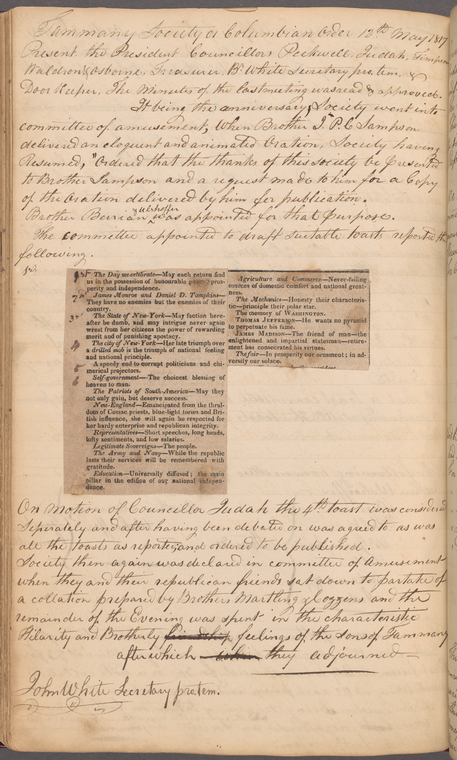Tammany Hall's Nineteenth-Century Retweets
You shouldn’t believe your own press. Tammany Hall probably took that to heart during their infamous days of Boss Tweed and Democratic machine politics. But earlier on in their history, they actively made their own press.
Founded in 1789, the Society of Tammany was a fraternal and benevolent society in New York City that focused on the celebration of American identity and culture. The minute books and records of the Society of Tammany from this early national period describe how the society elected its officers, accepted new members, and commemorated important anniversaries such as Washington’s Birthday, the feast day of St. Tammany, Independence Day, Columbus’s Birthday, and Evacuation Day. Each of these celebrations centered on the parades during the day and the patriotic orations and toasts given at public dinners in the evenings.
Alongside more mundane details such as fines for absences and administrative agendas, the Society of Tammany’s minute books have also preserved notes on the organization’s public relations efforts. For instance, the notes surrounding the preparations for and the accounts of events such as the Feast Day of St. Tammany and Washington’s Birthday reveal how much effort Tammany officers made to ensure that local newspapers would report on their events and would accurately print their orations and toasts.
For instance, at the meeting devoted to planning the 1815 Feast Day of St. Tammany, the officers determined that “the society meet on the evening of the Anniversary at 6 o clock and the Oration be delivered at 7 and that the Secretary publish the same in the newspapers.” Furthermore, the officers appointed a committee of its most important members including the society’s president, to “prepare suitable toasts for the occasion.”
On the following page, the writer describes how the society’s members—“joined by a number of their Republican Friends and honoured (sic) by the company of Several Ladies”—enjoyed the “Elegant and Animating Address” and “spent the evening in the most social and convivial manner.” This little snippet was meant to underscore the political relevance and elegance of the occasion. The “company of Several Ladies” deserved particular note because the presence of women was believed to have a calming force on the rambunctious, partisan politics and to be a guarantee of patriotic virtue and decorum.
After the handwritten description of the evening, the society’s secretary pasted a newspaper clipping of the toasts even though the toasts could have easily been handwritten. These newspaper clippings occur three more times in the Society of Tammany’s minute books in honor of Independence Day of 1815, the 1816 Feast Day of St. Tammany, and the 1817 Feast Day.
From a public relations standpoint, it was significant that the society’s celebratory toasts were printed and shared with the public. Pasting this newspaper clipping into their organization’s records functioned as a kind of early modern “re-tweet” and demonstrated the public’s recognition of the organization. In other words, that the local newspapers reported on their events both created and reaffirmed the Society of Tammany’s importance. These members of the Society of Tammany already knew that the newspaper coverage of their event was just as important, if not more important, than the actual event itself.
About the Early American Manuscripts Project
With support from the The Polonsky Foundation, The New York Public Library is currently digitizing upwards of 50,000 pages of historic early American manuscript material. The Early American Manuscripts Project will allow students, researchers, and the general public to revisit major political events of the era from new perspectives and to explore currents of everyday social, cultural, and economic life in the colonial, revolutionary, and early national periods. The project will present on-line for the first time high quality facsimiles of key documents from America’s Founding, including the papers of George Washington, Thomas Jefferson, Alexander Hamilton and James Madison. Drawing on the full breadth of the Library’s manuscript collections, it will also make widely available less well-known manuscript sources, including business papers of Atlantic merchants, diaries of people ranging from elite New York women to Christian Indian preachers, and organizational records of voluntary associations and philanthropic organizations. Over the next two years, this trove of manuscript sources, previously available only at the Library, will be made freely available through nypl.org.
Read E-Books with SimplyE
 With your library card, it's easier than ever to choose from more than 300,000 e-books on SimplyE, The New York Public Library's free e-reader app. Gain access to digital resources for all ages, including e-books, audiobooks, databases, and more.
With your library card, it's easier than ever to choose from more than 300,000 e-books on SimplyE, The New York Public Library's free e-reader app. Gain access to digital resources for all ages, including e-books, audiobooks, databases, and more.
If you don’t have an NYPL library card, New York State residents can apply for a digital card online or through SimplyE (available on the App Store or Google Play).
Need more help? Read our guide to using SimplyE.




